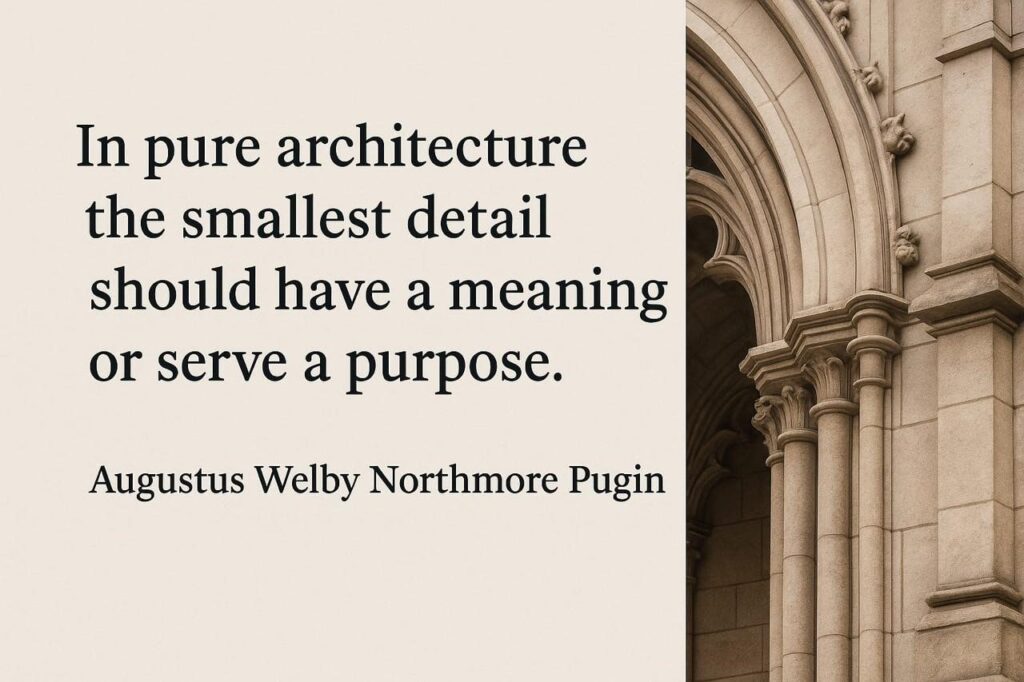~Augustus Welby Northmore Pugin Architecture, at its highest expression, is more than the assembly of walls, roofs, and openings it is the synthesis of art, philosophy, materiality, and function. The quote by Augustus Welby Northmore Pugin, a pivotal figure of the 19th-century Gothic Revival movement, reminds us that true architecture is not an arbitrary composition …

~Augustus Welby Northmore Pugin
Table of Contents
- Contextualizing Pugin’s Vision
- The Meaning of Detail in Architecture
- Functional Detailing: Form Serves Purpose
- Meaning in Detail: Beyond the Physical
- Contemporary Interpretations
- Minimalism: Detail Through Subtraction
- High-Tech and Parametricism
- Sustainable Detailing
- The Architect’s Responsibility
- Case Studies
- Returning to the Roots
Architecture, at its highest expression, is more than the assembly of walls, roofs, and openings it is the synthesis of art, philosophy, materiality, and function. The quote by Augustus Welby Northmore Pugin, a pivotal figure of the 19th-century Gothic Revival movement, reminds us that true architecture is not an arbitrary composition of forms, but a deeply intentional act. From the grandeur of a cathedral to the curve of a handrail, every element must resonate with purpose and meaning. As architects, we are called not just to build but to create environments that communicate, perform, and endure.
Contextualizing Pugin’s Vision
Pugin’s architectural philosophy emerged as a reaction to the industrial revolution’s mechanization of construction and the widespread decline of craftsmanship. He believed that architecture must be honest an embodiment of moral integrity, cultural continuity, and function. In this regard, detailing was not ornamental fluff but a carrier of narrative and function. The pointed arch, the buttress, or the tracery in a Gothic church wasn’t merely stylistic; it expressed structural logic and spiritual intent. In this sense, Pugin set a standard for what we now call “authentic architecture.”
The Meaning of Detail in Architecture
To Pugin, and to many who followed in his footsteps, architecture is a language. Details are its vocabulary. Every molding, joint, or joinery is a word in this complex grammar. A detail can:
- Convey structural truth
- Signify cultural meaning
- Respond to climate and context
- Enhance user interaction
- Elevate aesthetic quality
When detailing is approached with intention, the result is architecture that is legible and dignified. It feels resolved, natural, and timeless.
Functional Detailing: Form Serves Purpose
Functionality is the bedrock of good design. Details must first serve a purpose. This includes:
1. Structural Function
Details like expansion joints, beam connections, foundation footings, or waterproofing membranes might be invisible to the casual eye but are fundamental to the building’s performance. Pure architecture doesn’t hide or ignore these elements it celebrates and integrates them.
2. Environmental Responsiveness
Consider traditional Indian jaalis or Japanese shoji screens. These aren’t just decorative screens; they mediate light, privacy, ventilation, and thermal comfort. Similarly, deep overhangs in tropical climates or thermal mass walls in deserts speak to how details can respond to nature.
3. Ergonomics and Usability
Details shape user experience. The placement of a switch, the angle of a stair riser, or the curvature of a bench determines comfort and accessibility. When done right, such details enhance the everyday life of users.
Meaning in Detail: Beyond the Physical
Beyond function, detailing also communicates. This aspect of meaning in architecture elevates a building from good to great.
1. Cultural Symbolism
Vernacular and traditional architecture often embeds cultural motifs in construction. The carved torana in an Indian temple, or the calligraphic inscriptions on Islamic domes, are layered with historical and spiritual meaning.
Modern architects, too, can embed such meaning. Charles Correa’s Jawahar Kala Kendra reinterprets Vastu Purusha Mandala in its planning and detailing, offering a narrative rooted in Indian cosmology.
2. Material Honesty
Louis Kahn once said, “You say to brick, what do you want to be?” Detailing in pure architecture is about listening to materials honoring their strengths, limitations, and expressive capabilities. Exposed concrete, expressed joinery, or revealed fasteners reflect this ethos of honesty.
3. Storytelling Through Craftsmanship
Detailing is where architecture meets the hand. It’s the moment where drawing meets execution. Whether through hand-crafted joinery, CNC-milled panels, or digitally printed components, every detail is an opportunity to express the spirit of the building.
Contemporary Interpretations
Today, architects operate in a vastly different landscape one of BIM models, parametric design, and prefabrication. Yet, the ethos of Pugin’s call for meaningful detailing is more relevant than ever. In a world of mass production and superficial aesthetics, meaningful detail anchors architecture to its essence.
Minimalism: Detail Through Subtraction
Minimalist architecture seems devoid of details but in truth, it is an elevation of detail. Every line, joint, and shadow is meticulously considered. The flush baseboard, shadow gap, or frameless door becomes the detail.
High-Tech and Parametricism
Advanced fabrication and algorithmic design offer new vocabularies for detailing. The complexity of Zaha Hadid’s Heydar Aliyev Center or the articulation of Herzog & de Meuron’s Elbphilharmonie are modern explorations in purposeful detailing, where form, structure, and skin become one seamless expression.
Sustainable Detailing
In sustainable architecture, details are life-giving. Rainwater harvesting spouts, green wall anchoring systems, PV panel mounts, or operable facade louvers are all eco-details that function while expressing a commitment to the planet.
The Architect’s Responsibility
For an architect, detailing is not a late-stage decorative act; it is design in its most refined form. From the moment a concept is born, the architect must visualize how it materializes. The detail is where intention meets reality.
To achieve this:
- Understand materials deeply
- Collaborate with craftsmen and engineers
- Draw at full scale whenever possible
- Mockup, prototype, and revise
- Let context, climate, and culture guide choices
Case Studies
1. Louis Sullivan’s Carson Pirie Scott Building
Sullivan’s motto, “form follows function,” resonates with Pugin’s idea. The elaborate cast iron ornamentation at the entrance is not just decorative it marks the threshold, expresses modernity, and celebrates craftsmanship.
2. Peter Zumthor’s Therme Vals
Here, the detailing of quartzite stone, lighting, water flow, and spatial sequence creates a multisensory experience. Every groove, joint, and void in the stone walls is choreographed to enhance tactile and emotional resonance.
3. Laurie Baker’s Brick Architecture
Baker’s work is a masterclass in detailing with purpose. From rat-trap bonds to ventilation holes, each feature serves thermal comfort, cost-efficiency, and visual rhythm. He found elegance in economy a powerful lesson.
Returning to the Roots
In our race for speed, spectacle, and scalability, architecture sometimes forgets its soul. Pugin’s message reminds us that beauty is not in excess but in integrity. That the smallest detail a chamfered edge, a carved lintel, a textured surface can embody the story, function, and spirit of a place.
As architects, we must honor our responsibility to create not just buildings, but meaningful environments. We are not decorators of facades but storytellers in stone, steel, and space. And if we are to practice “pure architecture,” every detail must not only please the eye but engage the mind and uplift the spirit.
In the end, detailing is not just about precision it’s about presence. It is where architecture reveals its essence, one intentional line at a time.






